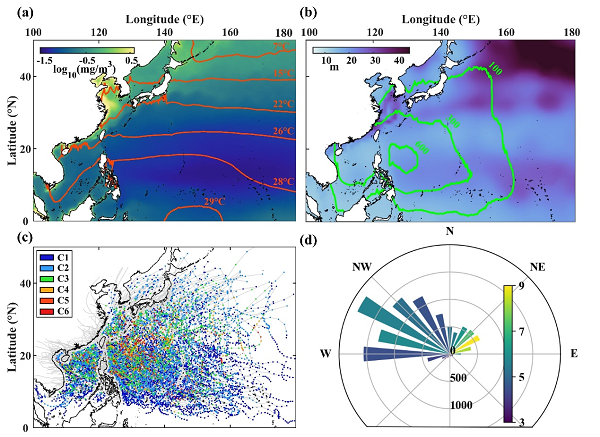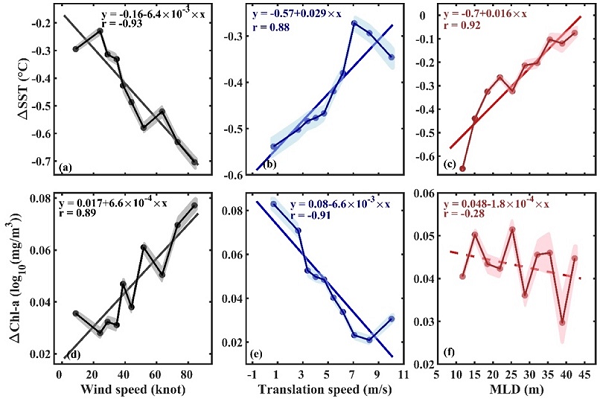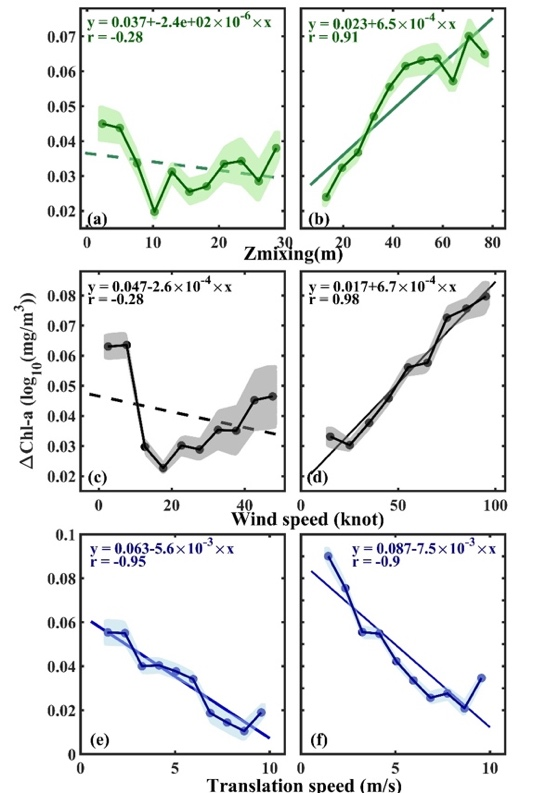Program
Recently, the marine ecological observation and simulation team of the SIO published the research result entitled “Upper ocean structure determines the contrasting typhoon-induced chlorophyll-a responses in the northwest Pacific” in the international journal Geophysical Research Letters. The first author is Jiang Yue, a graduate student of the SIO, the corresponding author is researcher Wang Yuntao, and the co-authors include Professor Tian Xinliang from Shanghai Jiao Tong University, Professor Chai Fei from Xiamen University, postdoctoral fellow Lin Sheng, associate researcher Chen Shuangling and graduate student Yu Jianmin from the SIO.
In the paper, a total of 476 typhoons recorded in the Northwest Pacific from September 2002 to August 2019, corresponding to 12259 typhoon data points (Figure 1), were utilized, and the sea surface temperature (SST) and chlorophyll data from satellite remote sensing were combined to obtain the marine environmental characteristics and typhoon distribution laws of typhoon prone areas.

Figure 1: (a) Climatological average chlorophyll distribution and SST contour in the study area; (b) Climatological average MLD and contour of cumulative distance from typhoon center less than 300 km frequency; (c) Trajectory chart of typhoons in the Northwest Pacific, with typhoon intensity ranging from low (C1) to high (C6); (d) Statistical average of typhoon translation direction and speed.
According to the composite analysis of typhoon characteristics and upper ocean structure characteristics, the article further explores the factors that affect the intensity of ocean response. It was found that typhoons with high intensity and low translation speed can drive more significant temperature and chlorophyll response (Figure 2). In addition, the pre-typhoon marine environment plays a leading role in determining ocean response. SST cooling is usually strong in a shallower pre-typhoon mixed layer depth (MLD) (Figure 2c).

Figure 2: Correlation of typhoon-driven (a/b/c) SST anomalies (ΔSST) and (d/e/f) chlorophyll anomalies (ΔChl-a) with typhoon characteristics and marine environment; the relationship with (a/d) typhoon wind speed, (b/e) translation speed and (c/f) MLD was analyzed by linear regression. The real point represents the average value of each interval, and the shadow represents the corresponding standard deviation. The solid line (dashed line) indicates that the linear regression is significant (insignificant) at the 95% confidence level.
The response intensity of upper chlorophyll-a is highly dependent on the upper ocean structure and the dynamic effect brought by typhoon, that is, the pre-typhoon MLD of the upper ocean and the typhoon-induced mixing depth (Figure 3). The typhoon-induced wind stress curl produces vertical mixing and upwelling in the ocean interior, leading to the deepening of mixed layer. When typhoon-driven mixing breaks through the original MLD, it can provide high-nutrient water for the upper ocean, promote the growth of phytoplankton, and significantly increase chlorophyll.

Figure 3: Based on the relationship between the typhoon-driven mixing depth (Zmixing) and the pre-typhoon MLD of the upper ocean, it can be divided into two cases: (a/c/e) Zmixing<MLD and (b/d/f) Zmixing>MLD, and the correlation between ΔChl-a and (a/b) Zmixing, (c/d) wind speed and (e/f) translation speed was analyzed. The real point represents the average value of typhoon points corresponding to ΔChl-a in each interval, and the shadow represents the corresponding standard deviation. The solid line (dashed line) indicates that the linear regression is significant (insignificant) at the 95% confidence level.
In this study, the statistical approach was used to confirm the mechanism of marine chlorophyll difference caused by different typhoons, and the influence characteristics of typhoon on the upper ocean were quantitatively assessed. It was concluded that the vertical structure of the upper ocean is an important factor determining the intensity of ocean response. This study can use typhoon characteristics and marine environment characteristics to predict the intensity of air-sea interactions, and explore the response of oceans in different sea areas to typhoons on a global scale.
Paper Citation:
Jiang, Y., Wang, Y., Tian, X., Lin, S., Chen, S., Yu, J., & Chai, F. (2023). Upper ocean structure determines the contrasting typhoon-induced chlorophyll-a responses in the northwest Pacific. Geophysical Research Letters, 50, e2023GL102930. https://doi.org/10.1029/2023GL102930.



